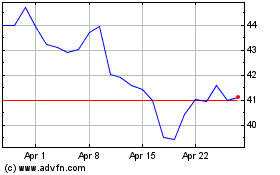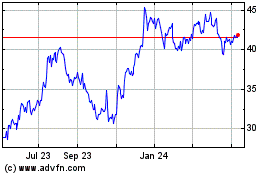Digital Payment Platforms Primed to Topple Cash
August 16 2017 - 10:27AM
Business Wire
U.S. Bank survey of consumers finds 47 percent
prefer digital payment options
With increased access to person-to-person (P2P) payment
services, consumers across generational lines report they prefer to
use mobile applications when paying other people as opposed to
cash.
According to the recent U.S. Bank Cash Behavior Survey, 47
percent of consumers surveyed say they prefer the use of digital
apps to make payments versus cash (45 percent). Breaking the
results down by generations, 49 percent of millennials (aged
19-36), 44 percent of Generation X (aged 37-52), and 32 percent of
baby boomers (aged 53-71) have made digital payments. That number
is expected to grow with Zelle, a new P2P payments network
that offers a fast, safe and easy alternative to checks and cash,
says Gareth Gaston, executive vice president of Omnichannel at U.S.
Bank.
“The incredible consumer response to digital and mobile banking
solutions is changing the entire industry and diminishing the
historic use of cash,” he said. “ATM withdrawals and branch visits
are slowly declining, while mobile transactions are increasing
dramatically year over year. In just the 30-day period since Zelle
launched within the U.S. Bank Mobile App, the number of P2P
payments sent by our customers have increased by more than 300
percent. It shows that the broad availability of free, easy-to-use
and fast-acting technology is supplanting the need for cash.”
Carrying Less Cash
The U.S. Bank Cash Behavior Survey also found that consumers
aren’t carrying much cash with them or using it for payments on a
frequent basis. Overall, 50 percent of survey respondents reported
carrying cash less than half of the time.
When they do carry cash, nearly half of consumers surveyed keep
less than $20 on hand, and 76 percent keep less than $50. The
instances where they spend this cash appear to be shrinking as
well, with 46 percent claiming they use cash fewer than eight days
each month, and 5 percent saying they never use it.
Addressing Consumer Concerns
Despite consumer preference for digital payments, only 43
percent of survey respondents reported making a P2P payment prior
to the launch of Zelle. When asked about the obstacles to initial
or more frequent P2P mobile payment use, consumers surveyed ranked
security and fees at the top of their list, followed by immediate
access to funds, risk and convenience.
Unlike the mobile payment systems offered by non-bank providers,
Zelle, which is backed by U.S. Bank and other financial
institutions, can directly address these issues.
“On top of secure in-app access, Zelle payments are sent and
received directly between bank accounts and use a registered email
address or mobile number—this avoids the introduction of a third
party and vulnerability of account information,” Gaston explains.
“It’s also important to note that every Zelle payment made by a
U.S. Bank customer is protected by our U.S. Bank Online Risk-Free
Guarantee. Together, these security measures make Zelle a much
safer platform for consumers.”
In addition, money sent using Zelle is typically reflected in
account balances within minutes when both the sender and recipient
are registered. Users can send and receive money between consumer
accounts at Zelle’s partner banks, which allows accessibility to
the majority of the U.S. banking population.
Additional Findings
The U.S. Bank Cash Behavior Survey uncovered a number of
additional insights:
- Forty-eight percent of men surveyed
have used P2P apps in the last six months versus 38 percent of
women.
- When using cash, consumers
participating in the survey prefer to spend it on dining (36
percent), travel/transportation (15 percent), parties (14 percent),
and family functions (14 percent).
- When using P2P digital payment
networks, consumers surveyed prefer to pay for bills (51 percent),
items from another person (40 percent), gifts (35 percent), and
concerts (8 percent).
- Seventy-three percent of previous P2P
users participating in the survey reported being more likely to use
a P2P service if payments are secure and backed by a bank, and 78
percent reported they are more likely to use a P2P service if they
can access funds almost immediately.
Bovitz, Inc. (an independent market research company) conducted
the U.S. Bank Cash Behavior Survey, a nationally representative
online survey on behalf of U.S. Bank, between June 1, 2017, and
June 7, 2017. Bovitz surveyed 2,003 participants throughout the
United States, comprised of adults ages 19-71 with a current
banking relationship (checking or savings), and who own a
smartphone. Additionally, 25 percent of survey respondents must
have used a P2P payment app in the past six months.
About ZELLE
Brought to you by Early Warning, an innovator in payment and
risk management solutions, Zelle makes it easy, fast and safe for
money to move. The Zelle Network connects the nation’s leading
financial institutions, enabling customers to send faster
person-to-person payments to nearly anyone with a U.S. bank
account. Funds are available directly to consumer bank accounts,
generally within minutes. To learn more about Zelle and its
participating financial institutions visit
www.zellepay.com.
About U.S. Bank
U.S. Bancorp (NYSE: USB), with $464 billion in assets as of June
30, 2017, is the parent company of U.S. Bank National Association,
the fifth largest commercial bank in the United States. The company
operates 3,088 banking offices in 25 states and 4,826 ATMs and
provides a comprehensive line of banking, investment, mortgage,
trust and payment services products to consumers, businesses and
institutions. Visit U.S. Bancorp on the web at
www.usbank.com.
Zelle and the Zelle related marks and logos are property of
Early Warning Services, LLC.
Deposit products offered by U.S. Bank National Association.
Member FDIC. Credit products offered by U.S. Bank National
Association and subject to normal credit approval.
View source
version on businesswire.com: http://www.businesswire.com/news/home/20170816005688/en/
U.S. BankMichael Walsh, 612-303-9122Vice President of Corporate
Communicationsmichael.walsh@usbank.com
US Bancorp (NYSE:USB)
Historical Stock Chart
From Mar 2024 to Apr 2024

US Bancorp (NYSE:USB)
Historical Stock Chart
From Apr 2023 to Apr 2024
